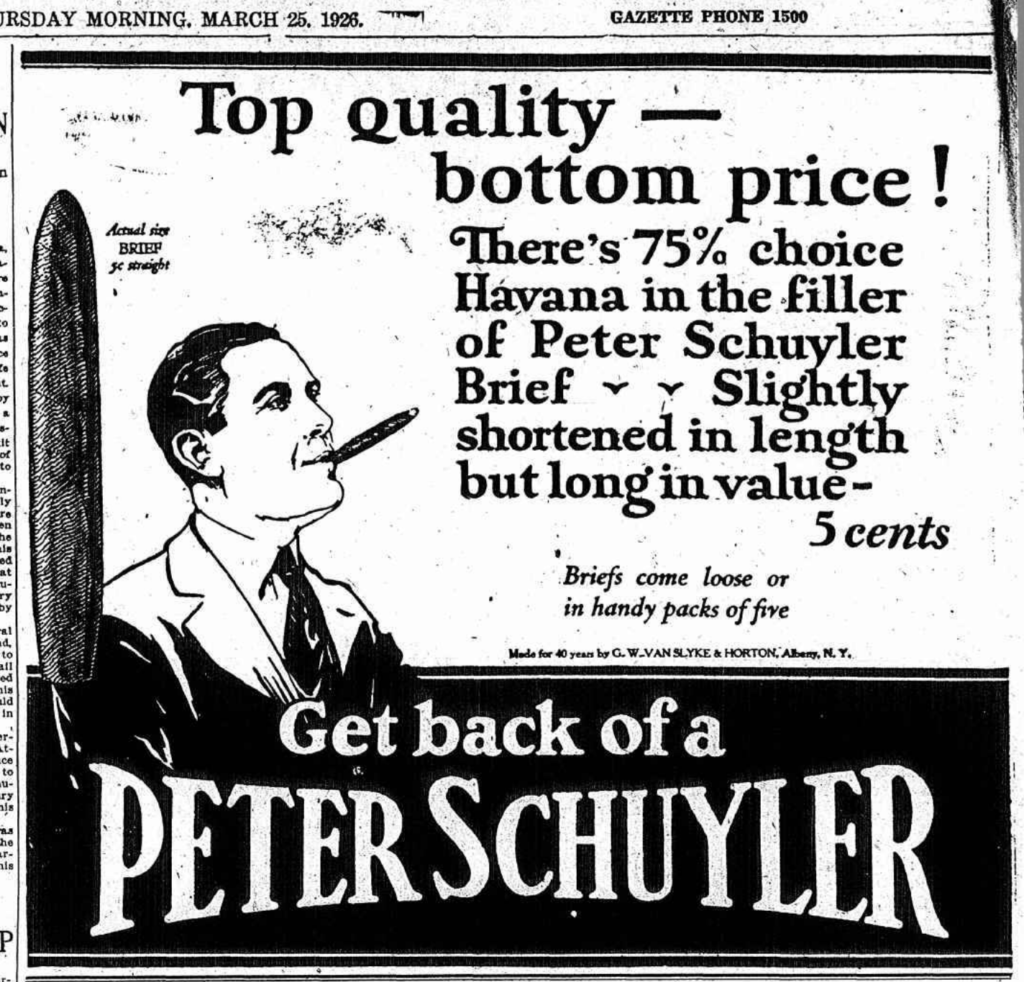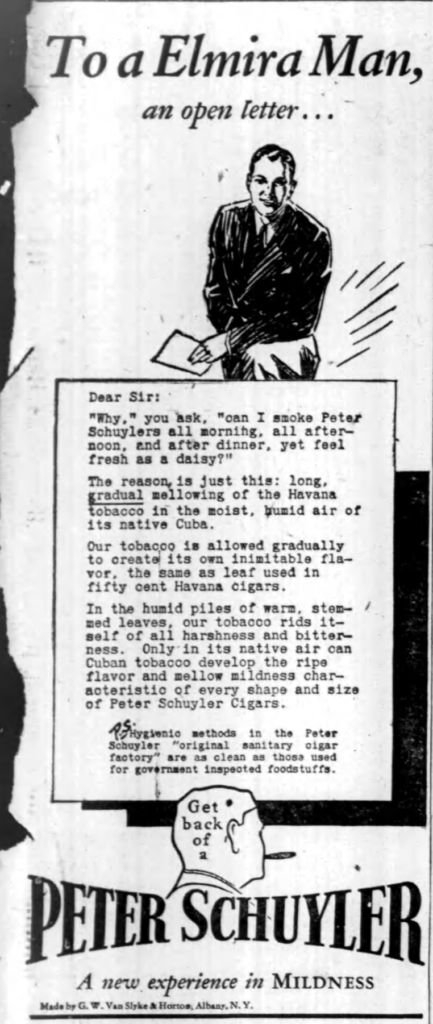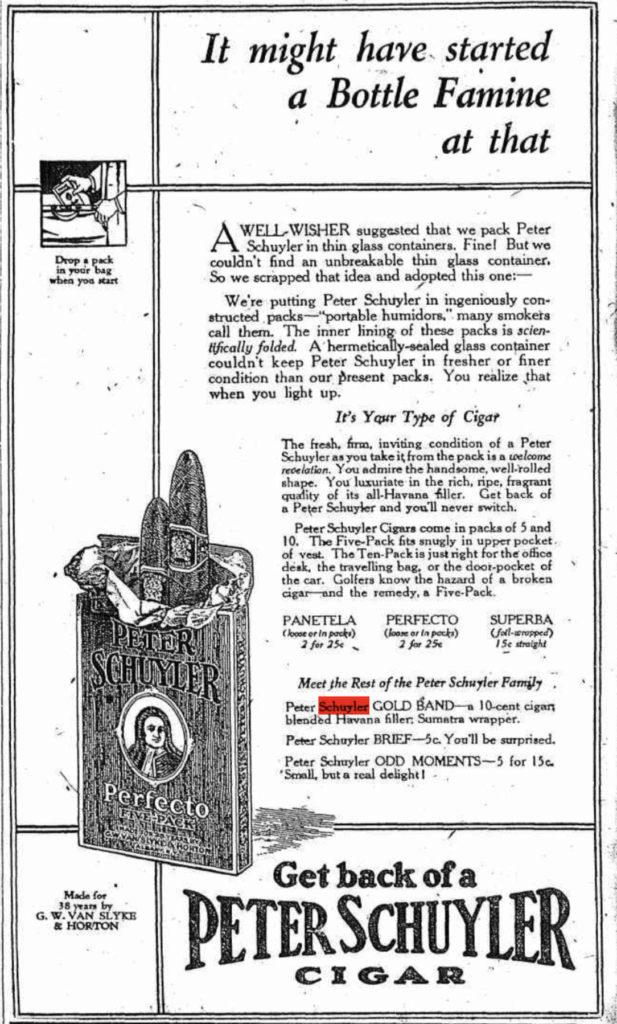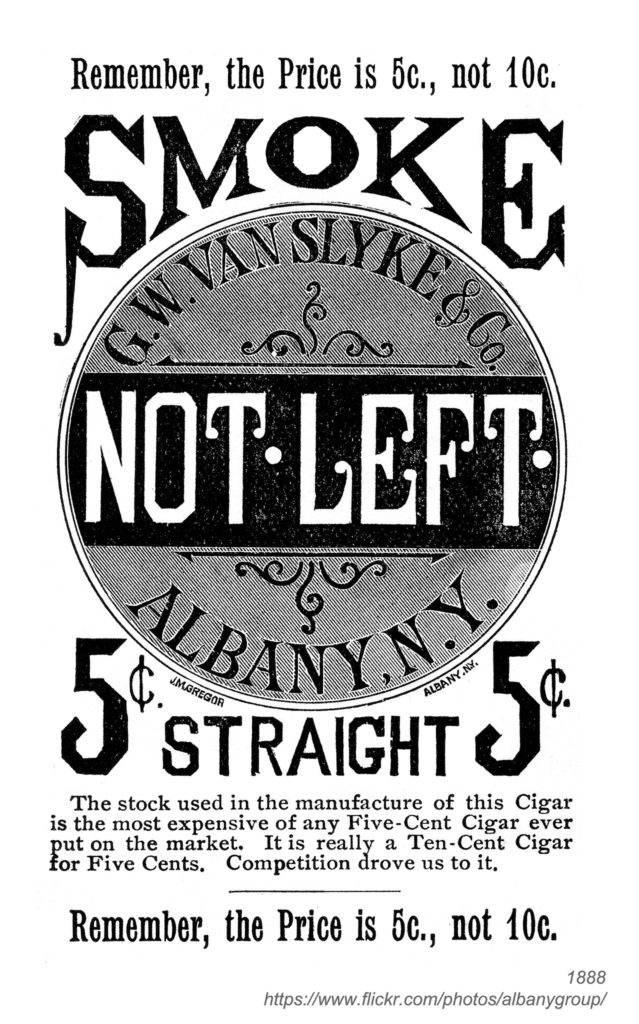
Scrolling through some old newspapers, this ad caught our eye — not only for its odd syntax (I mean, I guess I wouldn’t want to get in front of a cigar), but for its note that Peter Schuyler cigars had been made for 40 years right in Albany by G.W. Van Slyke & Horton. Turns out the company had quite a history (and much of the telling of that history in ads and newspapers got the dates quite wrong).
An ad from 1928 claimed that G.W. Van Slyke & Co. was established in 1867, but that was a little bit off. George Washington Van Slyke, born in Dutchess County around 1831, doesn’t show up in Albany until he first entered into partnership in 1867 with an existing tobacconist, Edward Gee. Gee appears to have come from Coeymans, where he was listed as a tobacco peddler in 1860. Gee came to Albany around 1865, selling tobacco at 399 Broadway, in the Commercial Building on the river side of Broadway between Hudson and Beaver, later part of the Plaza that now fronts the SUNY Administration Building. Gee had a partner named Edward Lyman in 1866, but Lyman went away and then Van Slyke joined Gee in 1867 at 377 Broadway. They moved to 40 State Street in 1868, remaining there in 1869. Then in 1870 they appear to have gone their separate ways, with Gee remaining in business at 40 State (at least through 1870) and Van Slyke operating under his own name at 417 Broadway.
In 1880, Wallace Horton, who had been an agent for the company, joined the firm, now known as G.W. Van Slyke & Horton. Beginning in 1885, according to their ad, their principal brand was the Peter Schuyler cigar, named for the first mayor of Albany.
“Empire State Industries” from 1888 offered a thumbnail sketch of the business:
One of the leading representatives both as jobbers in choice tobaccos, and manufacturers of the most popular brands of cigars on the market is that of Messrs. G.W. Van Slyke & Co. The business is old established, having been founded by Messrs. Gee & Van Slyke, twenty-one years ago. Mr. Gee retired in 1870, and with slight changes, Mr. Van Slyke continued the business up to 1880, when Mr. Wallace N. Horton came in under the existing name and style. Their facilities are perfect, and they have developed a trade of the greatest magnitude as manufacturers and jobbers. Their establishment is five stories in height, 23 x 180 in dimensions, and fully equipped throughout with the latest improved machinery and appliances; 175 hands are employed in the manufacture of all grades of fine cigars, produced from the choicest selected leaf, and of exceptional perfection as regards workmanship, flavor and uniformity of standard. The brands include the popular “Up and Up” cigar; the famous “Not Left,” “Royal Worcester,” “Happy Thought,” “Figaro,” “Suwanee River,” “P’s and Q’s,” “Horton’s Star,” “Pluck and Luck,” and choice Regalias from selected Havana and domestic leaf tobaccos. Their wholesale trade in cigars is of great magnitude, and extends all through this state, Vermont and New England States, and west to Michigan, while locally, no goods are so popular in our best cigar stores.
Van Slyke & Horton expanded greatly, and remained in the families. George Sr. died in 1891; George Jr. seems to have taken over his position as president. We’re not sure when Wallace Horton died or retired, but son Thomas took his place in the firm, and Charles B. Horton sold his interest in 1936. Remaining at 471 Broadway for many years (but apparently also with a factory at Arch and Grand for at least some of that time), after World War I, Van Slyke & Horton opened a grand new factory facility at 452-464 Clinton Avenue. That building still stands today, at least in part, as the home of the Salvation Army.

Cigars were big business. It was also a union business — a cigar makers strike began in May 1907 and ran at least through July, which led to a threat to close the Albany factory in favor of what was then a new plant in Kingston. In the end, though, both factories were put to use. By the time they were making a bond issue in 1922, Van Slyke & Horton owned factories in Albany, Kingston and Poughkeepsie, and leased an additional one in Catskill, and wanted the proceeds of bonds to expand because they were at full capacity in all those factories. They reported that their products were on sale in 50,000 stores in New York and New England, that sales had grown for 14 straight years, and that in the previous 38 years, there had only been one (1908) in which they failed to earn a profit.

The Peter Schuyler Cigar appears to have consistently been their biggest seller, and their most-advertised. An 1899 advertisement in the guise of an article in the Troy Daily Times tried to convince women it was safe for them to buy cigars as gifts for their husbands — as long as it was a box of Peter Schuyler 10-cent Perfectos. “There’s no question about their goodness. A vast host of smokers endorse them by their exclusive use of them. The firm which makes Peter Schuyler cigars guarantees them to be filled with genuine Havana and wrapped with Sumatra . . . They are light enough to be mild without a suggestion of being insipid.” We found Peter Schuylers advertised well into the 1950s, still with the phrase “Get Back of a Peter Schuyler.”
The company continued for years but sometime around 1936 closed the Albany factory and moved their operations to Kingston. An article in the Utica Observer said the firm had been sold to “a Cuban syndicate.” But they also reported, on July 20, 1936, that “G.W. Van Slyke and Horton of Albany and Kingston, manufacturers of cigars . . . with headquarters in Albany, have sold their cigar manufacturing business with the Kingston factory to a new operating corporation, G.W. Van Slyke and Horton Inc.” George Jr. continued to live in Albany, at 227 Lancaster Street, and was a director of the State Bank of Albany, on the board of Home Savings Bank, and on the board of trustees of the First Church. He died in March 1946.
Thomas A. Horton went with the company to Kingston as president; when he retired at the end of 1946, it was a division of the Schwartz Brothers Cigar Corporation.



We should mention that at least two of George Van Slyke Sr.’s houses still stand. In later years, he lived at the southwest corner of Elm and Swan, and a house he had built in 1881 by Fuller at 756 Madison is better known as Drislane’s house.

Leave a Reply